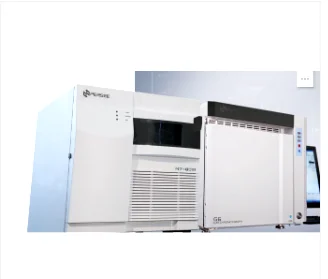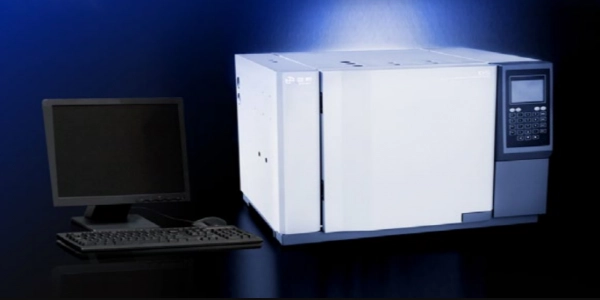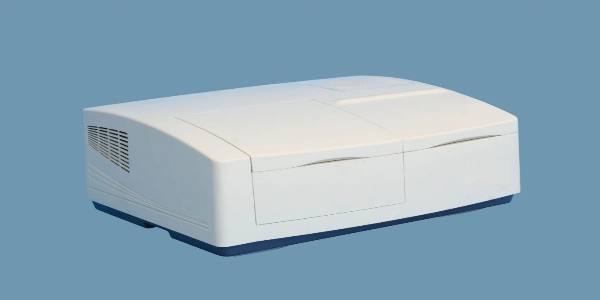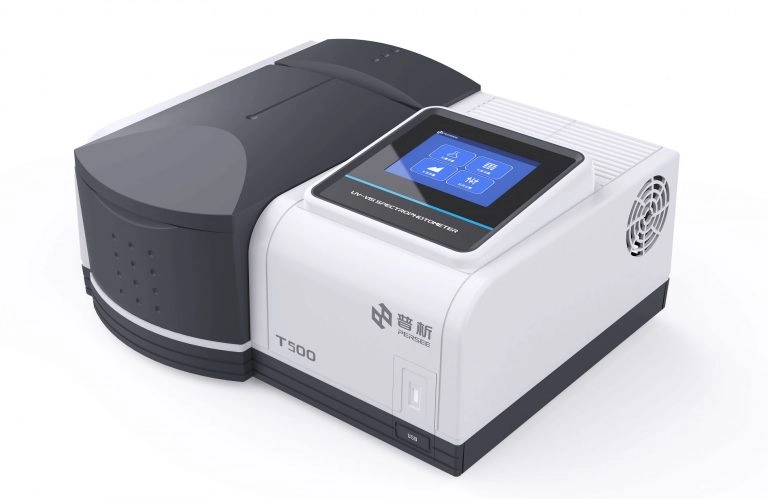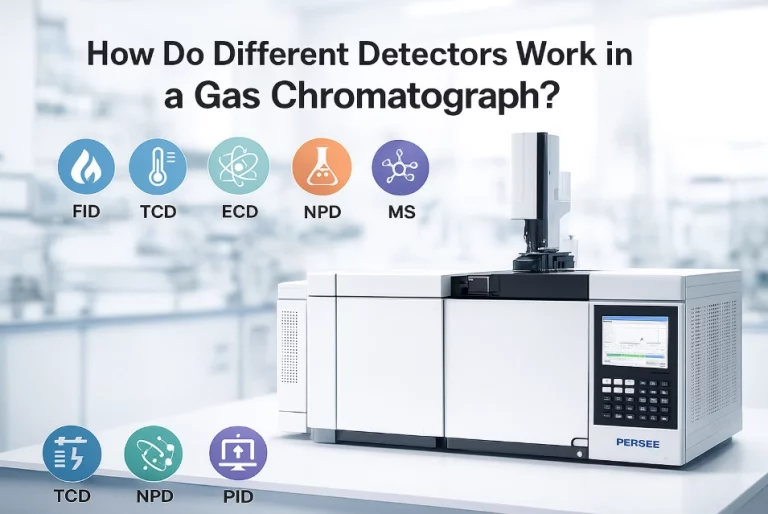Gas chromatography (GC) is a strong tool in analytical chemistry. It’s used to split and study substances in many fields. Whether you’re a lab worker, scientist, or quality checker, knowing how GC works can help you get exact results. This article explores the science of gas chromatography. It explains how it separates substances, its uses, and its strengths and weaknesses. At PERSEE, we’re dedicated to offering top-notch GC tools to meet your needs.
The Basics of Gas Chromatography
What is Gas Chromatography?
Gas chromatography is a method to separate and find volatile substances in a mix. It works by passing a sample through a tube. Substances interact differently with a fixed layer inside, so they split based on their traits. GC is great for analyzing things that turn into gas without breaking down, like organic materials or gases. This makes it a key method for clear chemical study.
The Importance of Gas Chromatography in Analytical Chemistry
GC is a vital part of analytical chemistry. It can spot tiny amounts of substances with great accuracy. It’s used in areas like environmental testing, drug making, and food safety. For example, GC can find pollutants in air or check a drug’s purity. Its flexibility and sensitivity make it essential for researchers and workers aiming for trustworthy results.
Key Components of a Gas Chromatography System
A typical GC system has several important parts:
- Injector: Puts the sample into the system, where it turns to gas.
- Tube: The core of the system, where splitting happens. It has the fixed layer.
- Carrier Gas: Acts as the moving phase, carrying the sample through the tube.
- Detector: Finds and measures the split substances.
- Data System: Records and studies the output, creating a chart.
These parts work together to ensure good splitting and study, as explained below.
The Principles Behind Compound Separation
The Role of the Mobile Phase and Stationary Phase
In GC, splitting depends on two phases:
- Moving Phase: An inactive gas, like helium or nitrogen, carries the gaseous sample through the tube. It doesn’t react with the sample, so substances move based on their traits.
- Fixed Phase: A liquid or solid coating inside the tube. Substances interact with this phase differently based on their makeup, leading to separation.
The balance between these phases decides how substances split. The fixed phase plays a big role in how long substances stay.
Factors Influencing the Separation Process
Several factors affect how well substances split in GC:
Interaction Between Compounds and the Stationary Phase
Substances that stick more to the fixed phase move slower. This causes longer stay times. For example, polar substances interact more with polar fixed phases. Non-polar substances move faster through non-polar phases. This “like-attracts-like” rule controls splitting quality.
Volatility and Boiling Points of Compounds
Substances with lower boiling points turn to gas easily. They spend more time in the moving phase, so they have shorter stay times. Less volatile substances stick more to the fixed phase. They take longer to come out. Tube temperature also affects volatility. Temperature changes are often used to improve splitting.
The Process of Gas Chromatography Step by Step
Sample Injection and Vaporization
The process starts with injecting a small sample into the GC system. The sample can be liquid or gas. It’s heated to 200–350°C in the injector. This turns it to gas instantly. This ensures substances are ready to move through the tube. Careful injection prevents overloading, which can cause poor splitting.
Transport Through the Column by Carrier Gas
The carrier gas, often helium or nitrogen, moves the gaseous sample through the tube. The gas’s flow rate is controlled carefully. A fast flow speeds up the study but may lower clarity. A slower flow improves splitting but takes more time.
Interaction Within the Column’s Stationary Phase
Inside the tube, the fixed phase—a thin layer of liquid or polymer—interacts with the sample substances. Each substance’s unique bond with the fixed phase makes it move at a different speed. This difference causes splitting. Substances come out at distinct times.
Detection and Data Analysis
As substances exit the tube, they reach the detector. It turns their presence into an electric signal. Common detectors include:
- Flame Ionization Detector (FID): Very sensitive for hydrocarbons, great for organic materials.
- Electron Capture Detector (ECD): Good for halogenated substances, used in environmental tests.
- Mass Spectrometer (MS): Gives detailed identification by studying molecule pieces.
The detector’s signals create a chart. This chart shows peaks for each substance’s stay time and amount.
Applications of Gas Chromatography Across Industries
Use in Environmental Analysis
GC is key for environmental testing. It detects pollutants like pesticides or volatile organic compounds (VOCs) in air, water, and soil. For example, GC with an ECD can find tiny amounts of chlorinated pesticides. This ensures compliance with environmental rules. Its sensitivity is perfect for tracking low-level contaminants.
Applications in Pharmaceutical Research and Quality Control
In drug making, GC ensures drug purity and spots impurities. It’s used to check leftover solvents in drug formulas or measure active ingredients. Our GC1100 Gas Chromatography System is built to meet the tough needs of drug quality control, giving reliable results.
Role in Food and Beverage Testing
GC is widely used in food safety. It detects contaminants like pesticides or additives. It also checks flavor compounds and fatty acids to ensure product quality. For example, GC can find trace levels of mycotoxins in food. This protects consumer health and meets regulatory standards.
Advantages and Limitations of Gas Chromatography
Benefits for Compound Analysis
High Sensitivity and Accuracy
GC can detect substances at parts-per-billion levels. This makes it great for trace analysis. Its precision ensures exact identification and measurement, vital for research and quality control.
Speed of Analysis
GC gives quick results, often finishing in minutes. This speed is valuable for busy labs, like those in environmental or food testing.
Challenges and Limitations
Suitable Compounds for Analysis
GC works only for volatile substances or those that turn to gas without breaking down. Non-volatile or heat-sensitive substances need special treatment or other methods like HPLC.
Equipment Cost Considerations
GC systems, including tubes and detectors, can be costly to buy and maintain. However, the long-term reliability and flexibility of systems like our G5GC Gas Chromatography System make them a smart choice for many labs.
PERSEE: A Trusted Partner for Gas Chromatography Solutions
Overview of PERSEE’s Expertise in Analytical Instruments
At PERSEE, we’ve been creating advanced analytical tools for over 20 years. We serve labs worldwide. Our expertise in gas chromatography ensures our systems deliver the accuracy and reliability you need. We understand the challenges of analytical chemistry. We design our products to meet your specific needs.
Key Features of PERSEE’s Gas Chromatography Systems
Our GC systems, like the GC1100 and G5GC, offer:
- High Sensitivity: Detectors like FID and ECD give accurate detection of trace substances.
- Flexible Options: Customizable tubes and fixed phases for various uses.
- Strong Design: Built for steady operation with little maintenance.
- Easy Interface: Simplifies operation and data review for all users.
These features make our systems perfect for environmental, drug, and food safety uses. For custom solutions, reach out at our contact page.
Conclusion
Gas chromatography is a flexible and strong method for splitting and studying volatile substances. By understanding the roles of the moving and fixed phases, the factors affecting splitting, and the step-by-step process, you can improve your GC studies for better results. At PERSEE, we’re committed to supporting your work with high-quality GC systems. Visit our homepage to explore our tools and boost your analytical skills.
FAQs
What types of compounds can be analyzed using gas chromatography?
Gas chromatography works for volatile substances or those that can turn to gas without breaking down, usually with weights below 1250 Da. Examples include organic materials like hydrocarbons, pesticides, and alcohols. Non-volatile or heat-sensitive substances may need special treatment or other methods like HPLC.
How does the stationary phase impact compound separation?
The fixed phase decides how substances interact and split in the tube. Polar fixed phases hold polar substances longer. Non-polar phases favor non-polar substances. The choice of fixed phase, like silicone or polyethylene glycol, affects stay times and clarity. It’s key for effective splitting.
Can gas chromatography be used for quantitative analysis?
Yes, GC is widely used for measuring amounts. By calibrating with known standards, GC detectors measure peak areas in the chart. This determines substance amounts. Methods like internal standardization ensure high accuracy. GC is ideal for measuring substances in complex mixes.


